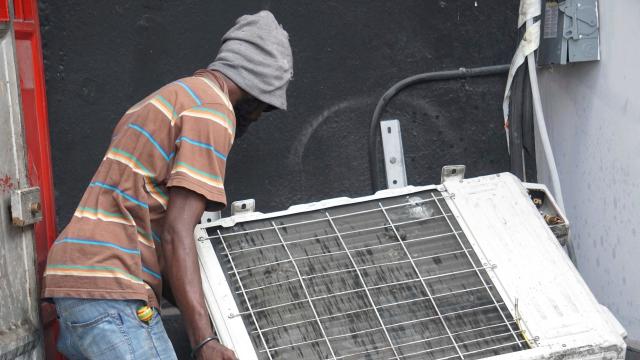In the 1930s, manufacturers began using chlorofluorocarbons—greenhouse gases made up of carbon, chlorine, and fluorine—as refrigerants for air conditioners, aerosol sprays, refrigerators, freezers, and more. The problem is, those chemicals depleted the ozone layer of the atmosphere, which blocks the sun’s damaging ultraviolet rays. That ozone depletion caused warming in the Earth’s coldest regions. In response to that growing hole in the ozone, in 1987 international leaders ratified the Montreal Protocol, pledging to stop using CFCs, so for the most part, they’re not used in production anymore, and the atmosphere is recovering slowly.
However, recent measurements show that emissions of one type of CFC, CFC-11, have actually increased since 2013 despite global reports of near-zero production since 2010. And atmospheric concentrations of other types haven’t been decreasing as quickly as researchers had projected. How is that possible?
Well, one major reason is that old products containing CFCs still emit the chemicals. And a new study, published in Nature on Tuesday, shows those stores—especially of CFC-11 and CFC-12—are much larger than previously thought. Both kinds were once commonly used as aerosol-spray propellants, refrigerants, solvents, and foam-blowing agents.
“We wanted to know how much emissions may be coming from old banks of materials versus new, illegal production,” the study’s lead author, Megan Lickley, told Gizmodo in an email.
The researchers developed a statistical model to assess the size of CFC stores. They estimate that emissions from current CFC banks could delay the recovery of the ozone hole by up to six years, creating a warming effect equivalent to 9 billion metric tons of carbon. For context, that’s the amount of carbon produced by using a billion gallons of gasoline.
“CFCs are harmful greenhouse gases,” Lickley told Gizmodo. “Pound per pound, their warming effect is between 5,000 and 10,000 times stronger than CO2.”
There are definitely other sources of these chemical emissions, including manufacturers, unwittingly or not, using them illegally. But to the climate, eliminating those CFCs would have a huge effect.
The Montreal Protocol doesn’t prohibit the use of old materials that contain CFCs, but policymakers have considered how to destroy CFC banks to help safeguard the ozone and climate.
“While 100% destruction of the banks is unrealistic, certainly some material can be recovered and destroyed (for example, via soil degradation of foams by careful burial in landfills instead of shredding,” the study says.
The study highlights the need for world leaders to figure out how to recover, locate, and dispose of these materials—and then to do so as fast as possible. There are definitely other sources of these chemical emissions, including manufacturers, unwittingly or not, using them illegally, and civic leaders should tackle those, too.
Doing so could prevent massive warming in the Arctic and Antarctic, which could help preserve glaciers and thereby prevent sea level rise. We’ll still have to rapidly phase out of emitting other kinds of greenhouse gases, of course.
But if we get the HFCs part right, studies show the hole in the ozone could heal in our lifetimes.
